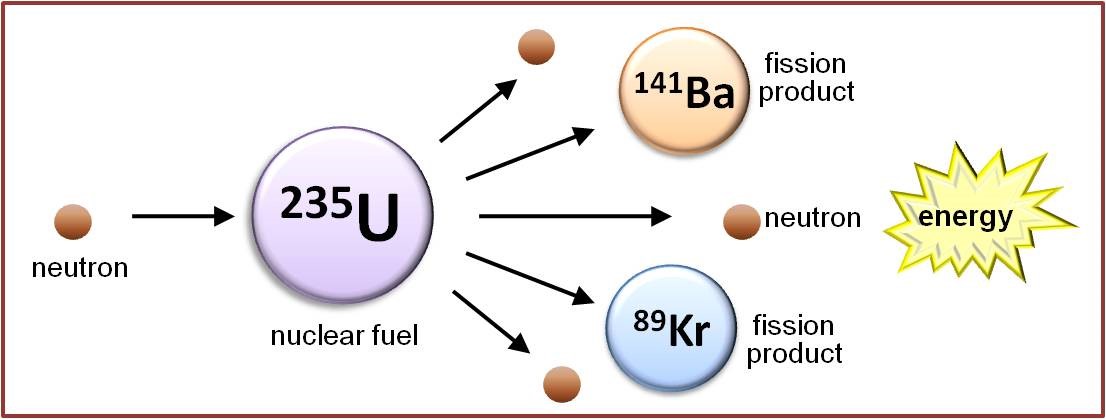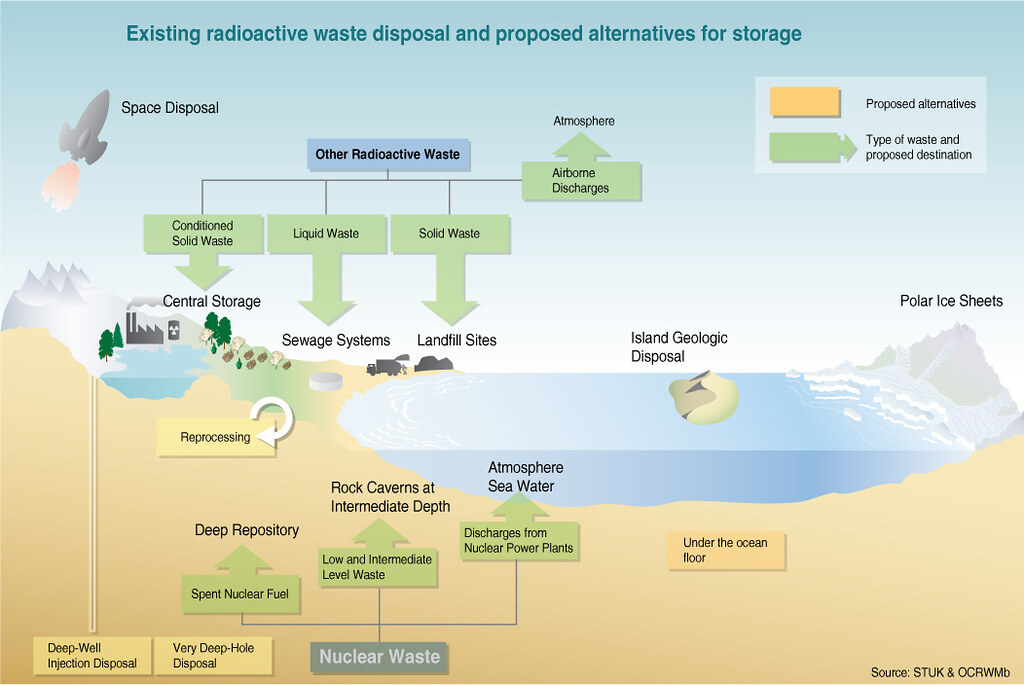Table of contents
Why in the News?
- Recently, India loaded the core of its long-delayed prototype fast breeder reactor (PFBR) vessel, bringing it to the cusp of stage II — powered by uranium and plutonium — of its three-stage nuclear programme.
- By stage III, India hopes to be able to use its vast reserves of Thorium to produce nuclear power and gain some energy independence.

- But the large-scale use of nuclear power is accompanied by a difficult problem: waste management.
What is Nuclear Waste?
- Radioactive waste is a type of hazardous waste that contains radioactive material and its byproducts.
- Radioactive waste is a result of many activities, including:
- Nuclear medicine
- Nuclear research
- Nuclear power generation
- Spent fuel rods
- Nuclear decommissioning and dismantling
- Rare-earth mining
- Nuclear weapons reprocessing
Generation of Radioactive byproducts
- They are generated as a result of nuclear fission.
- In a fission reactor, neutrons bombard the nuclei of atoms of certain elements. When one such nucleus absorbs a neutron.
- It destabilises and breaks up, yielding some energy and the nuclei of different elements.
- For example, when the Uranium-235 (U-235) nucleus absorbs a neutron, it can fission to barium-144, krypton-89, and three neutrons.


- If the ‘debris’ (barium-144 and krypton-89) constitute elements that can’t undergo fission, they become nuclear waste.
Spent fuel rods
- Fuel loaded into a nuclear reactor will become irradiated and eventually have to be unloaded.
- At this stage, it is called spent fuel.
- Spent fuel rods after energy production contains radioactive isotopes.
Examples of Nuclear Waste
- Argon 41
- Radioiodine
- Cobalt-60
- Strontium-90
- Tritium
- Caesium-137
Nuclear waste is highly radioactive and needs to be stored in facilities reinforced to prevent leakage into and/or contamination of the local environment.
What are the types of Nuclear Waste?

High-level waste (most dangerous)
- Spent fuel rods, liquids from reprocessing fuel.
- Needs isolated storage for thousands of years.
- It is primarily uranium fuel that has been used in a nuclear power reactor and is “spent,” or no longer efficient in producing electricity.
- This includes radioactive isotopes of lighter elements such as cesium-137 and strontium-90. These isotopes, called “fission products,”.
Intermediate-level waste
- Filters, cladding from fuel rods, reactor components.
- Requires careful management.
Low-level waste (least dangerous)
- It includes items that have become contaminated with radioactive material.
- Examples: Protective clothing, tools with low radiation contamination, shoe covers, wiping rags, filters, etc.
- These are disposable in shallow burial sites.
We can't clear UPSC for you.
But with our personalised mentor support, you'll be ready to do it yourself.
What happens to the Nuclear Waste?
- Spent fuel rods are still highly radioactive and hot due to residual decay heat.
- They are initially stored in water pools inside the reactor facility for several years to allow them to cool down.
- After cooling, they are transferred to dry cask storage on-site.
- These casks are heavily shielded containers designed to safely store spent fuel rods for decades.
How can Nuclear Waste be disposed of?


Shallow Burial
- Low-level waste, with minimal radioactivity, is disposed of in specially designed shallow burial sites with liners to prevent contamination of soil and groundwater.
- These sites are constantly monitored.
On-Site Storage
- Intermediate-level waste is typically stored on-site at nuclear facilities in shielded containers.
- Concrete casks or vaults are common storage solutions.
Geological Disposal
- This is a potential long-term solution for high-level waste disposal.
- The waste is encapsulated in special containers and buried deep underground in stable geological formations like granite or clay.
- But,
- Studies have pointed to the risk of radioactive material becoming exposed to humans if the containers are disturbed, such as by nearby digging activity.
Vitrification
- For high-level waste storage, vitrification is a process where the waste is converted into a glass-like substance for improved stability and containment.
Reprocessing
- It is the technology that separate fissile from non-fissile material in spent fuel.
- It presents the advantage of higher fuel efficiency.
- Some countries reprocess spent nuclear fuel to extract reusable fissile material like plutonium. (Like India)
- But,
- Because spent fuel is so hazardous, the reprocessing process is complex, and expensive, and creates additional waste streams needing disposal.
Transmutation
- This theoretical approach involves using advanced reactors to convert long-lived radioactive isotopes in waste into shorter-lived or stable isotopes, reducing their radioactivity.
- Transmutation technology is still under development.
What are the challenges of Nuclear Waste Management?
- Safe Storage: Finding a secure location for long-term (thousands of years) isolation.
- Spent fuel rods remain radioactive for thousands of years, posing a long-term waste management challenge.
- Transportation & Storage Technologies: Safe methods to move and store waste are crucial.
- Safe and secure storage of these rods is crucial to prevent radiation leaks and environmental contamination.
- Accident Risks: Contamination of water resources from leaks or accidents during storage/transport.
- Unknown unknowns: Uncertainties about long-term behavior of waste storage sites and reprocessing effectiveness.
- Ethical Concerns: Equity in waste storage (environmental justice) and burden sharing between generations.
- Cost factor: Waste management adds significantly to the cost of nuclear power generation.
What is the India's Scenario?
- According to a 2015 report from the International Panel on Fissile Materials (IPFM), India has reprocessing plants in Trombay, Tarapur, and Kalpakkam.

- The Trombay facility reprocesses 50 tonnes of heavy metal per year (tHM/y) as spent fuel from two research reactors.
- It produces plutonium for stage II reactors as well as nuclear weapons.
- Of the two in Tarapur
- One used to reprocess 100 tHM/y of fuel from some pressurised heavy water reactors (stage I).
- The other, commissioned in 2011, has a capacity of 100 tHM/y.
- The third facility in Kalpakkam processes 100 tHM/y.
- India has adopted the Closed Fuel Cycle option.

- It involves reprocessing and recycling of the spent fuel.
- Reprocessing plants extract plutonium for further use (stage II reactors and potentially weapons).
- During reprocessing, only about 2-3% of the spent fuel becomes waste.
- This waste is called high level waste (HLW).
- It is converted into glass through vitrification.
- The vitrified waste is stored in a Solid Storage Surveillance Facility for 30-40 years beforethe its disposal.
- The need for a final disposal facility will arise only after three to four decades.
- On-site storage facilities for low and intermediate waste with environmental monitoring.
Also, delays in the Fast Breeder Reactor (PFBR) program raise concerns about reprocessing plant efficiency. Why?
- According to the IPFM report
- The PFBR’s delays suggested the Tarapur and Kalpakkam facilities must have operated quite poorly, with a combined average capacity factor of around 15%.
- If and when the PFBR starts functioning and spent fuel from it is discharged – it will bring its own complications.
- Because it will have a different distribution of fission products and transuranic elements.
